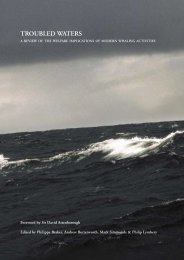Proceedings of the Untangled symposium: - WSPA
Proceedings of the Untangled symposium: - WSPA
Proceedings of the Untangled symposium: - WSPA
You also want an ePaper? Increase the reach of your titles
YUMPU automatically turns print PDFs into web optimized ePapers that Google loves.
Annex 4Submitted abstracts accompanyingposter presentationsRescueThe following abstracts are those submitted under <strong>the</strong><strong>the</strong>me <strong>of</strong> rescuing animals already entangled in (oro<strong>the</strong>rwise affected by) marine litter.Saving humpback whales entangled in gillnetsin EcuadorCristina Castro Ayala and Gregory KaufmanPacific Whale Foundation (PWF) – EcuadorAsunción 529 y Av. América. Edificio Cajiao. 4to piso.Quito – Ecuadorcristinacastro@pacificwhale.orgCetacean bycatch in fishing gear is recognized as one<strong>of</strong> <strong>the</strong> largest marine conservation issues worldwide.Interactions with fisheries occur mainly with artisanaland industrial fishing gillnets and both small and largecetaceans are involved. Ecuador is a major breedingarea for East Pacific humpback whales that migrate from<strong>the</strong>ir feeding grounds in Antarctica. Off <strong>the</strong> Ecuadorianmainland, humpback whales are found in <strong>the</strong> marine area<strong>of</strong> <strong>the</strong> Machalilla National Park from June to October.The whale watching tourism and fishing are <strong>the</strong> maineconomic activities <strong>of</strong> <strong>the</strong> Ecuadorian coastal towns.Overfishing has reduced fish stocks that producecommercial fishermen increase <strong>the</strong> effort (number <strong>of</strong>nets) and fishing time (No. <strong>of</strong> days <strong>of</strong> netting) in search<strong>of</strong> higher returns. In Ecuador <strong>the</strong> main gear is <strong>the</strong> gillnets surface. This gear has become marine debris thatis <strong>of</strong>ten lost or <strong>the</strong> charges for several days. The gill netsis plastic material and polyester fibers. They also containplastic ropes and buoys that flow from <strong>the</strong> fishing net.Since 2009 <strong>the</strong> PWF started a study to assess <strong>the</strong>level <strong>of</strong> interaction <strong>of</strong> cetaceans with fishing nets inMachalilla National Park. The project is based on directdata collection through field research trips in whalewatching boats. Recording and analysis <strong>of</strong> cetaceanstrandings. And awareness campaigns with fishermenand local community.From 2009 to August 2012 were 200 research trips whichfifteen humpback whales were seen towing gear or ropearound <strong>the</strong>ir body and <strong>the</strong>se are referred to as ‘entangledanimals’. In 60% (n=9) <strong>of</strong> cases were involved in fishingnets, were exhausted and swam slowly. The fishing netwas in pectoral fins, head and tail. Ano<strong>the</strong>r 40% (n = 6)were cases <strong>of</strong> humpback whales stranded dead wi<strong>the</strong>vidence <strong>of</strong> fishing gear in his mouth and body parts. Theevidence and analysis indicate that possibly stranding <strong>of</strong>cetaceans tangled in loose pieces <strong>of</strong> trammel nets at seaWe documented six cases (40%) successful rescue <strong>of</strong>humpback whales, 4 adults and 2 calves. Various actorswere rescue from fishermen, coastal communities,scientists, NGOs, divers and government staff. In allcases we used knives, machetes, clippers and hooks. Allanimals had a high degree <strong>of</strong> tiredness. In most cases<strong>the</strong> animals were rescued with direct approach.A preliminary estimate <strong>of</strong> 0,075 averaged entangledwhales/ trip. 89% <strong>of</strong> cases evidenced gillnets or trammelnets with mesh size <strong>of</strong> 5 inches, <strong>of</strong> which 10% wereelectronic (plastic mesh), 5% seines (different fibertypes), 6% undefined.The workshops with fishermen revealed <strong>the</strong> lack <strong>of</strong>government policies for <strong>the</strong> conservation <strong>of</strong> cetaceansand especially <strong>the</strong> lack <strong>of</strong> support to <strong>the</strong> fisheries sectorto find more environmentally friendly work alternatives.It requires better coordination between fisheries andenvironmental authorities, NGOs and fishing communitiesto address <strong>the</strong> problem in a comprehensive manner. Theworkshops showed that fishermen are willing to change<strong>the</strong>ir fishing gear, and try o<strong>the</strong>r methods that reduce <strong>the</strong>impact on cetacean populations and improve <strong>the</strong> quality<strong>of</strong> surface gillnets, avoiding network losses and damagecausing marine pollution problems.53
















